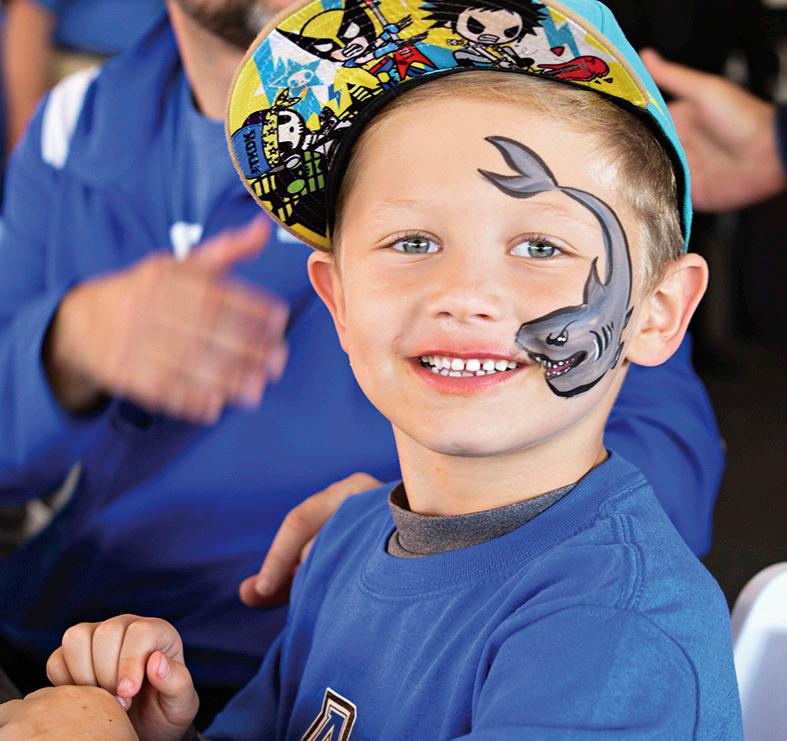Teaching the Teachers

FALL/WINTER 2022
TEACHER
THE YEAR KIM RADOSTITS ’14 MA IS ADVOCATING FOR THE PROFESSION SHE LOVES. ALSO IN THIS ISSUE: LIVING AND LEARNING IN MEMORABLE SPACES AURORA UNIVERSITY MAGAZINE
ILLINOIS
OF

Aurora University 347 S. Gladstone Ave. Aurora, IL 60506-4892
© 2022 Aurora University
Aurora University is accredited by the Higher Learning Commission to award degrees at the baccalaureate, master’s, and doctoral levels
Richard Larsen, a classical guitar instructor at AU, hand crafts guitars using cedar, spruce, and other woods from around the world. It takes about 150 hours to build each guitar. To read more about his craft, visit aurora.edu/news
AU has been teaching teachers since 1930. Today, AU is the Illinois state model for Educators Rising, a national program that recruits future teachers. page 8


Welcome to the premiere issue of the redesigned AU Magazine. The updated design reflects our commitment to telling the stories of Aurora University.
Teaching the Teachers
Kim Radostits ’14 MA is sharing with educators what she has learned about supporting students at risk of not graduating high school, and how those practices can uplift all students.
A Sense of Place
In the past 20 years, AU has invested more than $250 million to expand and improve the university’s physical presence, creating a campus that feels like home.
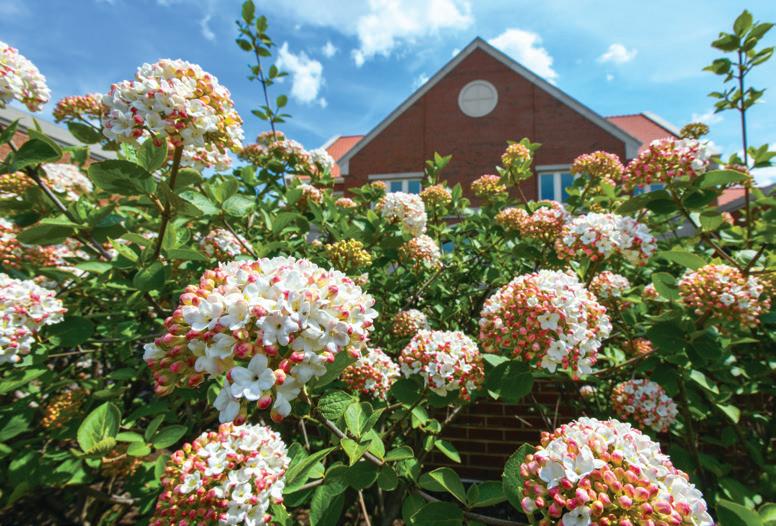
Contents
8 16
Features Cake Boss Tamara Turner ’12, ’14 MBA has taken her
of cake
the
page 26 Departments From the President 3 News of Note 4 Athletics 28 Giving 31 Faculty News 32 Arts & Culture 34 BackStory 36
President Rebecca
Senior Vice President for Enrollment and Marketing Deborah Maue Editor Sandra Jones Designer Jim Bernard Design Contributing Writers Andrew Faught Ashley Hacker H. Lee Murphy Jeremy Pittenger Richard Rothschild Christina Young Copy Editor Molly Heim Photographers Sam Krueger Sylvia Springer Contributing Photographer
Boehme
Magazine Fall/Winter
Volume 8, Issue 1
love
to new heights—35,000 feet into
stratosphere, to be precise.
L. Sherrick, PhD
John R.
Aurora University
2022
aurora.edu/magazine
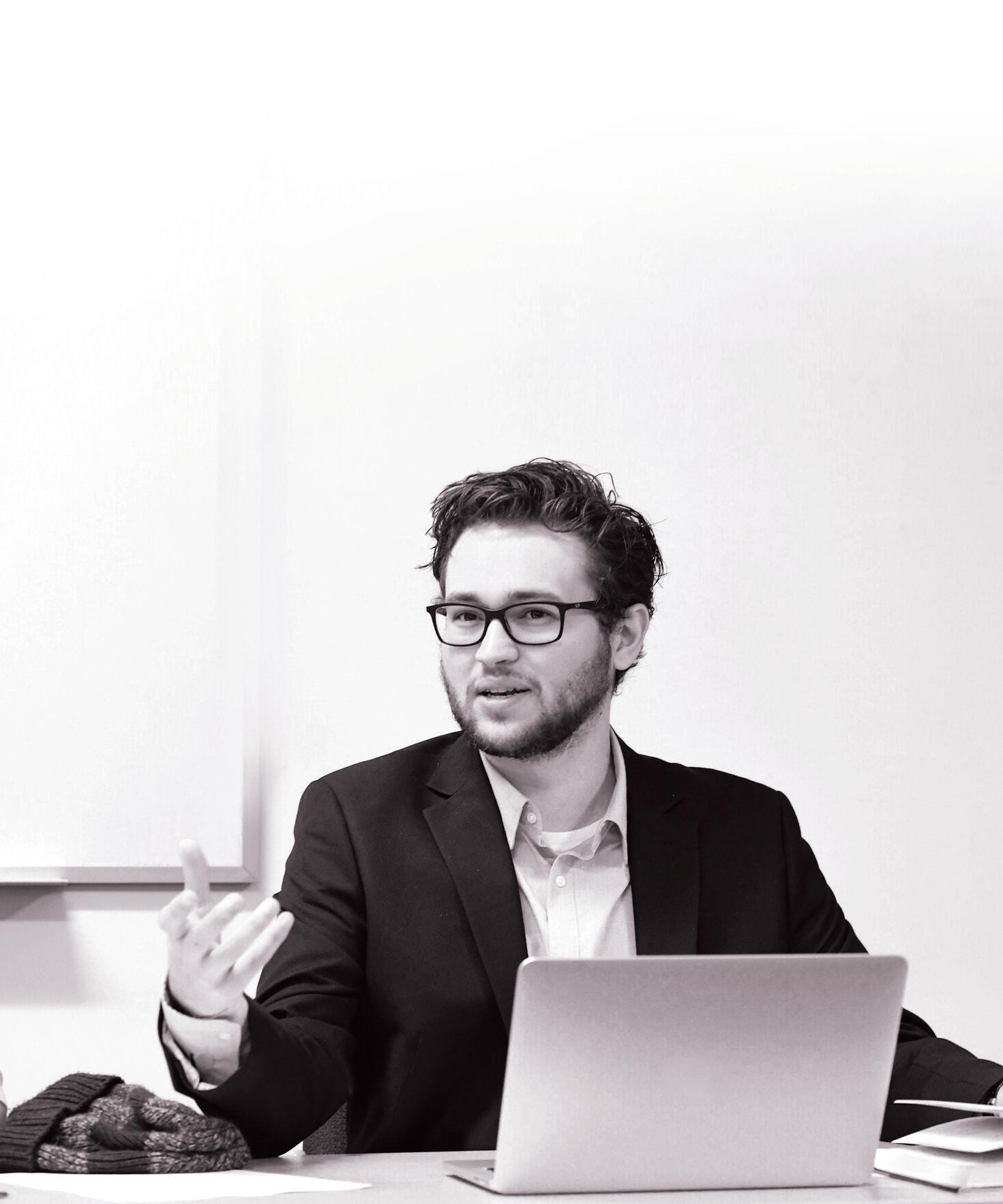
At AU, you will find the academic opportunities, real-world experiences, and employer connections to help reach your goals. Explore AU’s undergraduate, graduate, and endorsement programs, and get your future started today. YOUR FUTURE. OUR PROMISE. aurora.edu
You have a dream for your life. And the drive to make it real.
For a few hours
one bright October morning, I saw our work at Aurora University through several different lenses. The day began in the usual way with email to read and meetings to attend. Then it was off to greet prominent elected officials who long have championed our students through the legislative and appropriation processes in Washington and Springfield. They came with good news about a new federal investment in immersive academic resources that will benefit our nursing and health science students.
Throughout the curriculum, such high-tech tools deepen the learn ing experience. Long before they leave AU classrooms, for example, nursing students study human anatomy using life-like SynDaver models. They master vital skills with the assistance of high-fidelity patients, the “sims” that manifest human symptoms, emotions, and responses. Others don virtual reality headsets and are transported from campus to critical-care settings, where they work in collaborative teams with other healthcare professionals.
Today’s immersive technology resources are powerful. Just plain awesome. Even more so the students and faculty themselves. For me the most memorable moments in the visit came as students, faculty, and politicians discussed the need for well-educated nurses. Students spoke of wanting to help others, often mentioning the experiences of family members. AU faculty, meanwhile, voiced deep commitments to preparing nursing graduates to thrive in today’s complicated health care environment. The conversation was filled with hope and energy.
the Teacher of the Year. You will learn more about Kim and her work in the pages that follow. I love especially her stories about the personal strategies she uses to reach each learner—with a well-placed Post-it note or the friendly chime of a doorbell. Her passion, enthusiasm, and dedication are infectious.
Then it was on to Crimi Auditorium, where a large audience of faculty and staff had gathered for a briefing on the institution’s upcom ing review by a team from the Higher Learning Commission of the North Central Association of Colleges and Schools. Preparations for this important evaluation began almost two years ago. Now, thanks to this thorough self-examination, we are sharing our findings with evaluators and setting the stage for the next chapter of teaching and learning at Aurora University.
After over two decades on campus, I’ve enjoyed many such moments, opportunities to pause and to reflect upon the profound effect we have on the lives of our students. Through them, we touch the future. We impact the lives of people we will never meet in ways that we can never fully know. As I’ve said at so many Aurora University commencement ceremonies, “This is the magic, the transformative power of learning.” I am grateful to have shared in this mission for over two decades and look to the days remaining with optimism and anticipation.
After our visitors left, I met for a time with Kim Radostits ’14 MA, a teacher at Oregon High School. She earned her advanced degree at AU almost a decade ago and now is traveling throughout Illinois as Rebecca L. Sherrick, President


Aurora University Magazine | FALL/WINTER 2022 3
From the President
“I’ve enjoyed many opportunities to pause and to reflect upon the profound effect we have on the lives of our students. Through them, we touch the future.”
Nursing school receives funding for advanced technology labs
The School of Nursing received a $775,000 federal grant to bring advanced technology to its nursing labs.
The funds will be used to open the Center for Immersive Learning, a stateof-the-art, high-tech classroom with virtual reality and collaborative work stations to promote innovative teaching and learning practices in nursing.
The center, which is set to open in spring 2023, will comprise two new laboratory spaces for teaching and learning, a skills lab, and a simulation lab. It will also support augmented reality and virtual reality software for interactive patient simulations, a medication dispensing system used in hospitals, and a number of additional

intravenous infusion smart pumps for hands-on practice. The grant will also fund the purchase of simulation manikins of varying ages, genders, and ethnicities.

“Healthcare and healthcare technol ogy are changing at an incredible pace,” said AU Interim Chief Nursing Officer Nadja James, PhD, MSN, MHA, RN, CNE. “For our students to be successful in the healthcare system of today and the future, they must be proficient and comfortable with technology when they graduate from nursing school.”
The grant was secured with the assistance of U.S. Senator Dick Durbin of Illinois.
New residence hall named Don and Betty Tucker Hall
4 Aurora University Magazine | FALL/WINTER 2022 News
of Note
The university’s newest residence hall opened in August on the west side of campus, and the Board of Trustees passed a resolution to name the building Don and Betty Tucker Hall. The five-story building, originally called West Hall, is home to the Betty Parke Tucker Center for Neurodiversity, made possible by a generous gift from alumnus Don Tucker ’51 in memory of his late wife, Betty Parke Tucker ’52.
HAPPENINGS
FROM AROUND AU
AU gets a new look

Aurora University got a fresh look this past spring with a new logo, an advertising cam paign, and a redesigned website home page. The ad campaign—“Your future. Our promise.”— has appeared on billboards, streaming services, TV, and digital and social media since May. The goal of the campaign is to increase awareness of AU among prospective students and parents in northeastern Illinois.
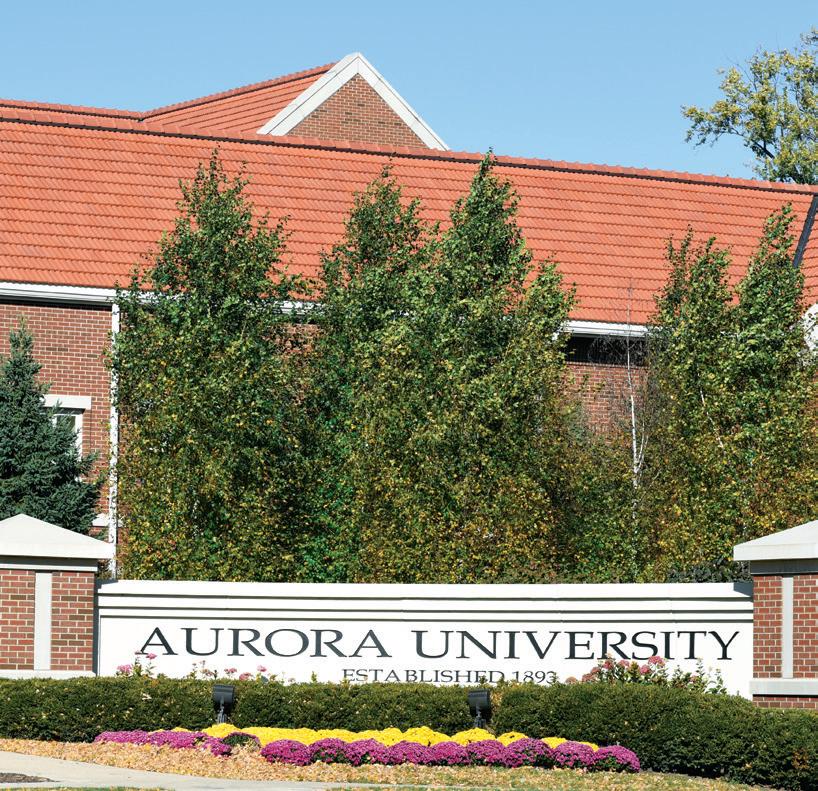
On Course: new classes in biology, health, social work
In the latest effort to partner with med ical and professional schools to help its students advance in the health science field, Aurora University has signed an agreement with the University of Illinois Chicago College of Medicine at Rockford to provide as many as five qualified AU seniors per year guaranteed admission to the Master of Science in Medical Biotechnology program
For students interested in healthcare, but unsure of what field to enter, AU created a new course that gives stu dents a firsthand look at the wide span of careers available in the fast-growing fields of health science and healthcare. The Introduction to Healthcare course
explores more than 30 professional roles available to students interested in health and medical fields.
Separately, AU has expanded its Mas ter of Social Work program to include a military and veteran social work track. The track includes specialized coursework that explores topics such as military culture, customs, and traditions and clinical social work practice with mil itary and veteran populations. AU is one of only two universities in Illinois to offer the track and one of 18 in the nation. The track is offered through AU Online and open to all MSW students at any of AU’s locations.
This past summer, Rebecca L. Sherrick, PhD, informed the campus community of her decision to conclude her tenure as Aurora University’s 13th president at the end of the 2022–2023 academic year, after more than 22 years of service.
President Sherrick has served as AU president since 2000, making her one of the longest-serving presidents since the institution’s founding in 1893. She is also AU’s first female president. Under her leader ship, AU has experienced record growth, expanding its enrollment to rank among the top 10 largest private not-for-profit universities in Illinois, while maintaining strong financial health.
The Board of Trustees has appointed and charged a committee with carrying out the search for AU’s next president and has retained executive search firm WittKieffer. The search process is expected to conclude in spring 2023, with the next president in place by the start of the 2023–2024 academic year.
To gain broad feedback from the AU community on the search, AU held listening sessions in Octo ber. Nominations of candidates for consideration are welcome from all members of the AU community. For more updates on the presidential search or to submit a nomination, visit aurora.edu/presidential-search
Aurora University Magazine | FALL/WINTER 2022 5
President Sherrick announces her decision to leave AU; presidential search is underway
New dean, directors join expanding student success efforts
Allison Brady, Dean of Students
Building teams comes naturally to Allison Brady. As a lacrosse player and coach for students from middle school through college, she has spent her career encouraging students to work together to succeed. Brady joined Aurora University in July as the new dean of students. She comes to AU from Concordia University in Chicago, where she was assistant dean of students for community standards and Title IX coordinator.
“Seeing that students are using the library so often and are engaging with the staff in different ways is really grati fying.”
latest ways libraries are developing to support students and help them succeed.
Before coming to AU, she worked at Northern Illinois University for 17 years, where she was most recently head of user services and associate professor. McHone-Chase earned undergraduate and graduate degrees in English language and literature from Illinois State University and a master’s degree in library and information science from the University of Illinois Urbana-Champaign.
“I’m eager to take the professional experience
I have gained and use it to best meet the needs of all of our students.”
Before moving into administrative roles in higher education, Brady earned accolades as a coach. She built an NCAA Division III women’s lacrosse team from the ground up at Elmhurst University, where she was head coach and Title IX investigator. She also coached youth and high school competitive travel lacrosse as director of operations at the American Youth Lacrosse Association in Wheaton. And she was named NAIA National Women’s Lacrosse Coach of the Year while at Robert Morris University in Chicago.
Brady began her career as a Spanish teacher for middle and high school students. She earned an undergraduate degree from Eastern Illinois University and an MBA from Elmhurst University. She is currently working on her EdD from Northern Illinois University.


“I’m eager to take the professional experience I have gained and use it to best meet the needs of all of our students as they pursue their degrees and engage in their college experience,” she said.
Sarah McHone-Chase, Director of the University Library
Shortly after Sarah McHone-Chase joined AU as director of the University Library in June, she and the other librarians set up puzzle pieces at a “Relaxation Station” in the library lobby and asked passersby to stop and put a piece or two in place.
Working on puzzles loosens up your mind, said McHone-Chase. It’s a tactile, fun activity for building community, and a way to reengage with students after the long stretch of pandemic separation.
“Seeing that students are using the library so often and are engaging with the staff in different ways is really gratifying,” she said.
An Illinois native, McHone-Chase has been involved in the evolu tion of Illinois libraries for most of her career. She has held leadership roles at the Illinois Library Association, the Illinois Association of College and Research Libraries, the Reaching Across Illinois Library System, and the Consortium of Academic and Research Libraries of Illinois. Her service and contributions keep her current on the
Justin West, Executive Director
of the Wackerlin
Center and Chief Diversity Officer
Justin West is dedicated to creating inclusive communities. As the newly appointed executive director of the Wackerlin Center for Faith and Action and chief diversity officer, he is eager to provide opportunities for students to learn from each other’s differences.

“I want to ensure that it is a place where students can experience an authentic sense of welcome, belonging, and inclusivity,” he said.
West comes to AU from Xavier University in Cincinnati, where he served as the Protestant chaplain and the director of the Faith and Race programs. Before that, he worked as a youth minister and directed nonprofit youth programs. West has strong ties to the Aurora community, where he lived for more than a decade.
“I am excited to join the ongoing work of imagining how the Wackerlin Center can change and expand to better serve each new class of students and contribute to the AU mission,” he said.
West is currently completing his doctoral dissertation at Indianapolis-based Christian Theological Seminary. He earned his Master of Divinity from Fuller Theological Seminary in Pasadena, California, and his bachelor’s degree from Wheaton College in Wheaton, Illinois.
“I want to ensure that it is a place where students can experience an authen tic sense of welcome, belonging, and inclusivity.”
6 Aurora University Magazine | FALL/WINTER 2022
Richard Price and Linnea Windel receive honorary degrees

AU presented honorary degrees to two distinguished leaders who embody the values cherished by the university.

The Board of Trustees, with the enthu siastic support of the faculty and administration, bestowed the degree of Doctor of Human Letters on Richard S. Price and Linnea Windel ’96 MSN in recognition of their collaborative spirit and dedication to the community, work to ensure access to quality educational opportunities for all, and commitment to citizenship through their tireless efforts to meet the needs of others. The presentations took place at the 2022 Commencement ceremonies in May.
In 2021, he was honored for his commit ment to diversity, equity, and inclusion as the recipient of the Daniel H. Burnham Award for Distinguished Leadership pre sented by the Chicagoland Chamber of Commerce.
Linnea Windel ’96 MSN has been presi dent and CEO of VNA Health Care since 1999. A tireless advocate for access to quality healthcare for all, Windel has led the transformation of the organization into




A Look Back to the Dog Days of Summer
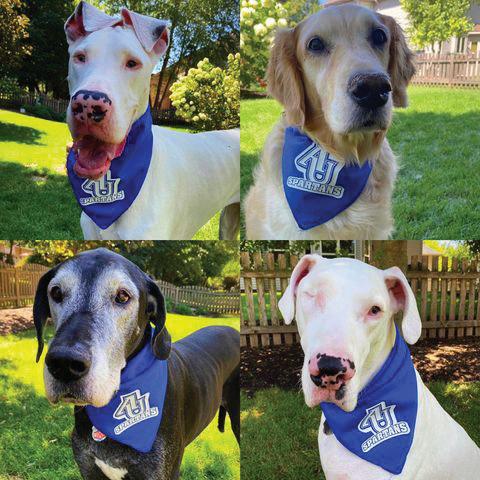
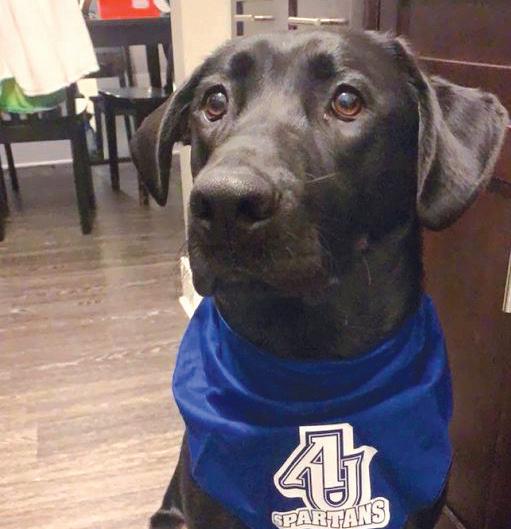
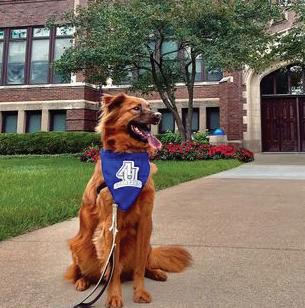
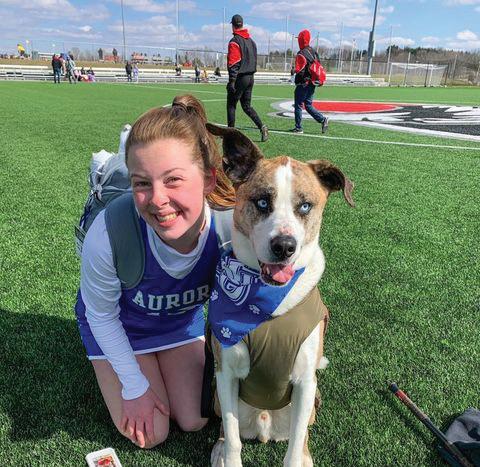
Richard S. Price is executive chairman of Mesirow, an independent, employee-owned financial services firm founded in 1937. In this role, Price is actively involved in organizational strategy, civic and commu nity engagement, and the firm’s focus on diversity, equity, and inclusion.
Over the course of 50 years with Chicago-based Mesirow, Price has been a key driver of the firm’s vision and success, serving in prior years as chairman and CEO, president and chief operating officer, and president of insurance services. He has been a member of the Mesirow Board of Directors since its inception in 1987. Price joined the organization in 1972 to establish the firm’s insurance services business, which was sold to Alliant Insurance Ser vices in July 2016.
a diversified community health network, serving suburban Chicago with compre hensive primary care, home-based nursing and medical services, and a variety of wellness and public health programs.




Throughout her career, she has devel oped a child abuse and neglect reduction program, created the first Medicarecertified hospice in Kane County, and launched a nurse practitioner house-call service. She was also instrumental in establishing VNA as the first Aurora-based federally qualified health center to provide medical care for those with little or no health insurance. She has served on the Aurora University Board of Trustees since 2013. Windel earned a Bachelor of Science in Nursing degree from Illinois Wesleyan University and a Master of Science in Nursing degree from AU.

Aurora University Magazine | FALL/WINTER 2022 7
Black Jack Jessika McCleskey ’19
Delta, Bailey, Tatum, Finley Alexandra Ziemann ’18
Ike Matthew Saitta ’16 and Emily Kasprzyk ’17
Charlie Caitlin Cron ’24
We celebrated National Dog Day in August by sharing some of the cutest pup pics of our furry Spartan companions on Instagram.
the

TeachingTeachers
Kim Radostits ’14 MA is spending her year as Illinois’ top teacher advocating for the profession she loves.
AS THE 2022 Illinois Teacher of the Year, Kim Radostits ’14 MA spends much of her time traveling around the state speaking to college students about the trials and joys of being a teacher.
What she has discovered along the way surprised her.
“One question that keeps coming from teaching candidates is, ‘How do you avoid teacher burnout?’” said Radostits. “It made me wonder why that’s on the radar of someone who hasn’t even started teaching yet.”
This past fall, as children went back to school, media coverage warned of a national teacher short age reaching crisis level. Terms like “catastrophic” and “looming crisis” and “five-alarm fire” dominated the headlines.
The reality is more nuanced. America’s national teacher short age isn’t national, and certainly not new, according to education experts. There are struggles to find teachers in rural school districts, and in cer tain subject areas including special education, languages, mathematics, and science. But that has long been the case in education.
“There are hardships in teaching,” said Radostits. “I believe teacher burnout is real. But, for the vast majority of us, there is so much joy that comes from this job. We have an ability to make an impact on society on an even greater scale than we realize, especially in rural school districts. We can make students feel known and valued. All those things are real too.”
Ms. Rad, as her students call her, has taught Spanish at Oregon High School in Oregon, Illinois, for the past 15 years. After receiving the state’s highest teaching honor in March, she began an ambassa dorship to share her knowledge and expertise with other educators around Illinois as part a yearlong state-funded sabbatical.
Her goal is to advocate for the profession she loves. She wants to spread the techniques she helped develop at Oregon High School to motivate at-risk children. She wants to demonstrate how those prac tices can be applied to uplifting all students. And she wants to share with other teachers how supporting each other and measuring incre mental successes can help them stay engaged and passionate even when facing challenges.
8 Aurora University Magazine | FALL/WINTER 2022
“
Cover Story
We have an ability to make an impact on society on an even greater scale than we realize.”
Since 1970, the Illinois State Board of Education has sponsored the Teacher of the Year program to honor educators who have made significant contributions to the state’s public and nonpublic elementary and secondary schools.

It is easy to see why Radostits rose to the top of her pro fession. She is passionate about the children she teaches and the troubles they face, and effective at motivating them to do better.
It wasn’t always that way.
Hawks Take Flight
It was 2012, and Radostits was in her fourth year of teaching at Oregon High School. She had played a key role in the development of the school’s highly acclaimed Hawks Take Flight program, which provides freshman students at risk of falling behind in school with out-of-theclassroom mentoring to ensure they stay on track to graduate.
The program was receiving a lot of attention and praise for its success, and Radostits was feeling at the top of her game—when a freshman boy who was failing his classes stopped her in her tracks. He hated school. He wanted no part of the Hawks Take Flight program. And he certainly didn’t want her help.
“It was a pivotal moment,” she said. “I started to look at school through his eyes and see what some of the shortcomings are for students like him. He was by far my biggest challenge, and the experience changed the trajectory of my career.”
Radostits dedicated herself over the next four years to getting him through school. The student became Radostits’ teaching assistant his junior and senior years, succeeded in graduating, and landed a full-time job.
Deep Pockets
Radostits’ favorite teaching tool came about by hap penstance. She needed a place to keep close at hand all of the items she uses while working with her students. So she tried a waitress apron, and it worked. She first donned it during the Hawks Take Flight after-school program. Now she wears it in her Spanish class as well.
“I get more questions about my apron,” said Radostits, who often brings it on the road when speak ing to groups of teachers. “It’s one of my favorite items. I’m as effective as I am because of all the things I carry inside.”
Her “teaching apron” has eight pockets and ties around her waist. In it she stows dozens of pencils, whiteboard markers, Post-it notes, paper squares, flash cards, her phone, her daily schedule, keys for class rooms, a remote for PowerPoint presentations, and a doorbell to get students’ attention when they need to stop what they’re doing and listen to directions.
“One of the things that escalates a student’s mood is coming unprepared,” she said. “So if a kid comes to class and doesn’t have a pencil, I don’t even ask. I just give them one.”
The Post-it notes come in handy as hall passes, notes of praise, and class reminders. If a student comes into class in a bad mood or is tired, she will write, “Are you OK?” and ask the student to circle yes or no.

Every kid deserves to have an adult who believes in them, an adult who is a cheer leader. I can be that for my students.”
The effort led Radostits to dig deeper into how to teach students who have adverse childhood expe riences that result in trauma. She worked with administrators to develop an Early Warning System program to identify junior high school students in need of extra sup port, and intervene before they start their freshman year of high school.
The more she learned, the more she realized that the same tools she was using for her at-risk students apply to all students, and she began to incorporate those teaching techniques in her Spanish classroom every day.
“If you use the notes in multiple ways, the kids won’t know why you are handing them out, their peers won’t know what it says, and it doesn’t have a negative stigma,” she said.
In the midst of Radostits’ development as a class room teacher, she enrolled in Aurora University, at the urging of her then-principal P.J. Caposey, who was an AU adjunct professor at the time. The AU graduate program built her confidence and gave her a new perspective on taking what she learned in the class room and sharing it with other teachers and outside institutions.
Radostits earned her MA in Educational Leader ship from AU in 2014, after graduating from Northern Illinois University in 2007 with a BA in Spanish Lan guage and Literature. She keeps in touch with Caposey today and continues to rely on him as her mentor.
10 Aurora University Magazine | FALL/WINTER 2022 “
Cover Story
“I told Kim that the job of leadership is to see people in ways greater than they see themselves,” said P.J. Caposey, Radostits’ mentor and an adjunct professor at AU when she earned her degree.
Indeed, Caposey was one of the first people she called when she found out she had won the Illinois Teacher of the Year Award.
“I told Kim that the job of leadership is to see people in ways greater than they see themselves and to help them imagine that picture,” said Caposey, who is cur rently superintendent of the Meridian School District in Stillman Valley, Illinois. “I continued to paint that pic ture for Kim, that she already had more influence and was more dynamic than she imagined.”
‘Never a Dull Day’
AU has been teaching teachers for almost a century. In 1930, Aurora College, which later became AU, received Illinois state authority to train elementary and sec ondary teachers, marking the beginning of one of the institution’s most successful and longest-standing aca demic programs.
Today, AU offers more than two dozen programs and endorsements in education at the undergraduate, grad uate, and doctoral levels. More than 4,500 AU graduates are making a difference in schools throughout the state as teachers, principals, and superintendents.


1930 4,500 30 24
Aurora University Magazine | FALL/WINTER 2022 11
AU has been teaching teachers since 1930.
AU ALUMNI WORKING AS TEACHERS, PRINCIPALS, AND SUPERINTENDENTS IN ILLINOIS ILLINOIS SCHOOL DISTRICTS EMPLOYING AU EDUCATION GRADUATES
EDUCATION PROGRAMS OFFERED AT AU
“When we train educators and send them out into the field, we are making long-term investments in the community as a whole,” said AU Professor Deborah Stevens, with elementary education student Casey Hettinger ’23.
The things she carries
Aprons aren’t just for cooks, waitresses, and hardware clerks. High school Spanish teacher Kim Radostits ’14 MA (Ms. Rad to her students) wears an apron in her classroom to allow her to move about and improvise with her students. The “teaching apron” has made her a better teacher, she said.
Here are some of the things in Ms. Rad’s apron: Vocabulary flashcards Schedule for the day Keys for the classrooms

Dozens of pencils Post-it notes Paper squares
Remote for PowerPoints Doorbell Band-aids
Cover Story
AU is the Illinois state model for Educators Rising, a national organiza tion that cultivates teachers by working with high school students interested in education careers.


The university has taken a lead in identifying where the biggest needs are for teaching positions in Illinois and working to recruit and train teachers to fill those posts.
In 2020, AU received a grant from the National Science Foundation Robert Noyce Teacher Scholarship Program to help increase the recruitment of high school and transfer students to the fields of science, technology, engineering, and mathematics. The goal is to create a pipeline of math and science teachers to work at Illinois high schools serving Hispanic students.
The university is also working with local high schools to recruit more teacher candidates to earn their English as a Second Language/Bilingual endorsements.
“When we train educators and send them out into the field, we are making long-term investments in the community as a whole,” said Deborah Stevens, professor of education and chair of the Initial Licensure and Early Childhood Education with ESL/Bilingual programs. “We have become adept at adjusting to the needs of the surrounding community.”
Another way AU is developing teachers is through Educators Rising, a national organization that cultivates educators by working with high school students interested in a teaching career. AU is the Illinois state model for Educators Rising.
Originally founded as Future Teachers of America in 1937 by the National Education Association, the organization relaunched in 2015 as Educators Rising supporting grow-your-own teacher programs across the country. The group reports that 60 percent of teachers teach within 20 miles of where they went to high school, making the work AU is doing locally that much more meaningful.
Aurora University Magazine | FALL/WINTER 2022 13
Training New Teachers in One Year



In the university’s most recent effort, AU created a new program for stu dents who have graduated in a field other than education to return to school to earn their degree in teaching in just one year. The first cohort of the new Master of Arts in Teaching graduated from AU in May.

Jennifer Aguilar ’20, ’22 MAT was a Biology and Health Sciences major working as a government lab technician when she returned to AU to earn her teaching degree in hopes of encouraging more diversity in the science professions. Today, she is a science teacher at Aurora West High School.

“As a woman of color in STEM, I have the power to set an example for my students and to expose them to the many STEM careers” Aguilar said.
Cooper Smith ’22 MAT took a job teaching history and social studies at the Lake County Regional Safe School in Vernon Hills, Illinois, where he works with students who have been expelled or are facing expulsion from their home high schools. He came to AU after earning his bachelor’s degree in history at Washington State University.

“I didn’t go searching for a behavioral school, but when I found it some thing clicked,” said Smith. “The people I work with are very passionate and driven, and we talk about how working with these kids is challenging but also rewarding when progress is made. Working is never a dull day.”
Rachel Metcalf ’18, ’22 MAT is a sixth grade English and science teacher at Kaneland Harter Middle School in Sugar Grove, Illinois. An AU English major, she worked as a social media marketing specialist, a stage manager at a local theatre, and an assistant manager of a clothing store chain, when some soul-searching led her to education.
“I came back to be a teacher because I wanted to inspire children who

“
Working with these kids is challenging but also rewarding when progress is made.”
—COOPER SMITH ’22 MAT
children who don’t believe in themselves or maybe need a push in the right direction.”
—RACHEL METCALF ’18, ’22 MAT
“
As a woman of color in STEM, I have the power to set an example for my students and to expose them to the many STEM careers.”
14 Aurora University Magazine | FALL/WINTER 2022 Cover Story
—JENNIFER AGUILAR ’20, ’22 MAT
The first cohort of the new Master of Arts in Teaching graduated from AU in May.
don’t believe in themselves or maybe need a push in the right direction,” said Metcalf.
As for Radostits, now that she has a platform as the Illinois Teacher of the Year she is working to get the Hawks Take Flight intervention program and Early Warning System out to as many schools as possible.
“I want to get this to a lot of rural school districts,” she said. “I’m hoping to go statewide and even bigger.”

She is also putting together a lesson plan of her own for teachers on how they can avoid teacher burnout. Her secret: metrics.
Although teachers are mandated to collect data for accountability pur poses, they can also collect data for themselves to measure progress in the classroom. Sharing those measure ments with fellow teachers and even with students helps keep perspective when it feels like you’re stuck, or just having a terrible day, she said.

Radostits measures student prog ress in all sorts of ways: attendance, completed assignments, scoring a C or higher on a test, and going to a sports event or after-school activity.
“When I see a student get four F’s instead of five, that’s something to celebrate,” she said. “That’s a student that was likely spiraling out of control, and we’ve done something to bring the student closer to being on track. It may seem like a small win, but we’ll take what we can and build on that,” Radostits said.
“Though these situations require a lot of energy, the students renew me,” she added. “If you’re able to step back and see the bigger picture, you can connect with your bigger purpose and see that you’re making progress, and that fuels you to do better.”
How one teacher rocked it in the early days of the pandemic
When the COVID-19 pandemic hit more than two years ago, Jennifer Lauermann ’01 MA was searching for a way to keep her fifth grade science class engaged.
Lauermann was relegated to holding her science classes in the cafeteria, the only space at Pleasantdale Middle School in Burr Ridge, Illinois, that students could safely keep the required six feet apart. Without lab tables or the ability to conduct experiments, she had to come up with a new way to approach science lessons.
After doing a bit of research, she discov ered that Illinois had a state bird (cardinal), state flower (blue violet), state tree (white oak), state fruit (GoldRush apple), state animal (white-tailed deer), and even a state dance (square dancing)—but no state rock.
She asked her students, most of them ages 10 and 11, to look into possible candidates for the honor. Sandstone and limestone and coal all were put forward. The students broke up into frenzied teams campaigning for their chosen rock. They hung posters around school. They wrote letters to college geology professors seek ing their expert opinions. And finally they polled students around the state, asking them to vote for their favorite rock.
The surprise winner: dolostone, a sedi mentary rock that underlies much of Illinois and that has figured into the construction of countless historic buildings, including the Old State Capitol in Springfield. It is also used in road construction and con crete production, and to remove pollutants from industrial facilities.
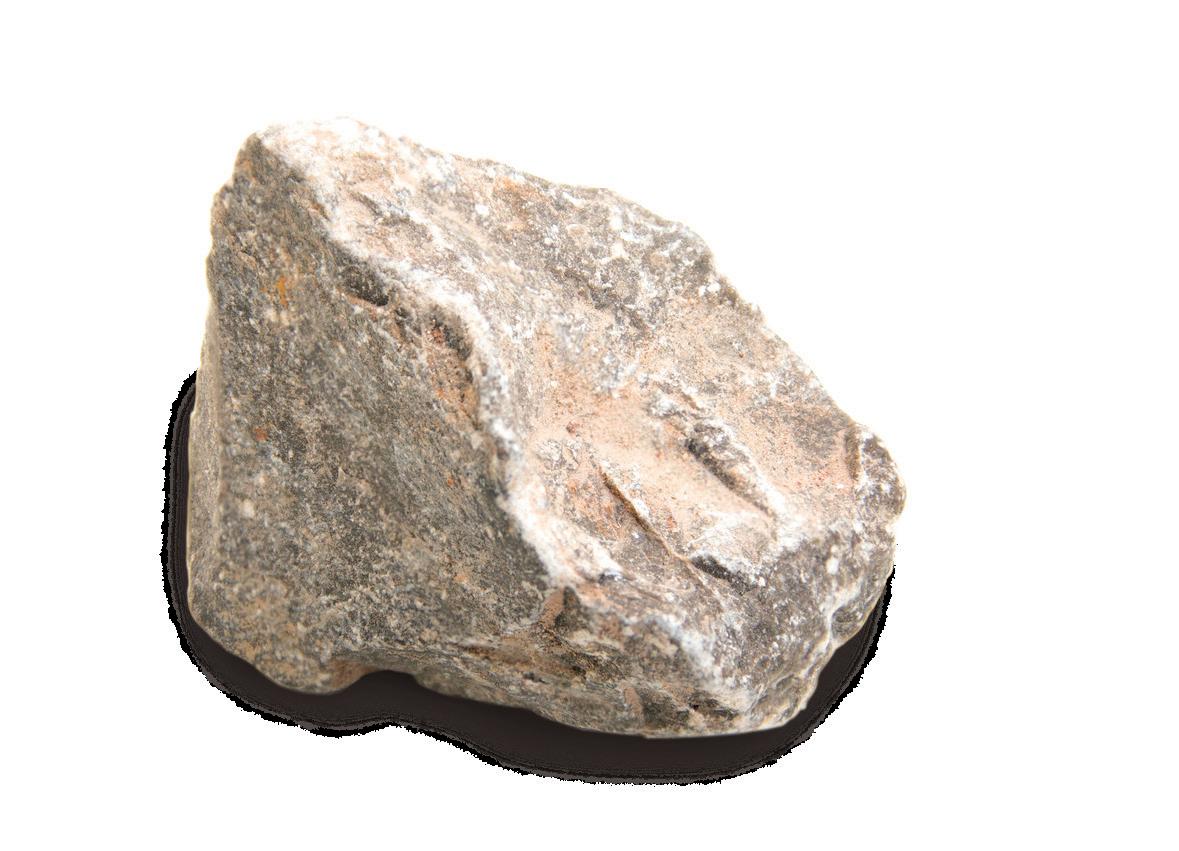
The students then went about the busi ness of lobbying to get dolostone officially named the state rock of Illinois. They found sponsors for the bill in the statehouse, who succeeded in introducing legislation earlier this year. At last, two years later, in a June ceremony at the Morton Arboretum in Lisle, Illinois, Governor J.B. Pritzker signed the bill into law, officially naming dolostone the state rock of Illinois.
“My students (now seventh graders) learned about politics and the process behind laws getting passed,” said Lauermann. “This took so long that they also learned the value of patience.”
The 47-year-old Lauermann, a graduate of West Aurora High School, completed her master’s degree in Educational Leadership at AU in 2001, three years after earning her bachelor’s degree from Illinois State Univer sity. Her AU leadership training has helped her to think beyond the classroom.
Lauermann oversees a science club that has launched recycling campaigns, persuaded school administrators to install solar panels on the school’s roof, created pond refuges for fish, and lobbied legisla tors to save natural prairie lands around the state.
“I hope projects like the state rock contest will inspire other teachers,” said Lauermann. “The students are so creative. They just need an idea and they run with it. This was a highlight of my teaching career, and these real world opportunities are such valuable lessons for everyone involved.”
A of Sense
Place



Tucked among the tree-lined streets of mid-century ranch homes and walking trails, the Aurora University campus is filled with spaces that invite contemplation, comfort, and inspiration.
The university has been educating students on a modest stretch of land just 2 miles west of the Fox River since 1912, when its founders moved the college from Mendota to Aurora, Illinois. The campus has flourished over the years, expanding from its three initial buildings—Eckhart, Davis, and Wilkinson halls—to more than two dozen buildings today.
How a college campus looks and feels can play a big role in the success and well-being of its students. AU consistently receives accolades from parents, students, alumni, and friends for the university’s pristine beauty and uplifting learning environment. It is with intention that AU has created a campus that feels like home.
“The truth is that we are all affected by our surroundings,” said Jen Buckley, senior vice president for student success at AU. “Given that most students spend four years of their time here, the spaces where they live, study, work, play, and reflect matter deeply.”
AU’s campus has grown dramatically over the past two decades with new residence halls, classrooms, performance halls, an athletic park, a welcome center, a parking garage, a museum, gardens, and a labyrinth.

Aurora University Magazine | FALL/WINTER 2022 17 What Connects Us
Years of Growth
In 2000, a new era of growth began under the tenure of President Rebecca L. Sherrick. In the past two decades, AU has invested more than $250 million in expanding and improving the university’s physical presence. The number of major buildings multiplied by more than half, and the footprint grew by more than 43 percent.
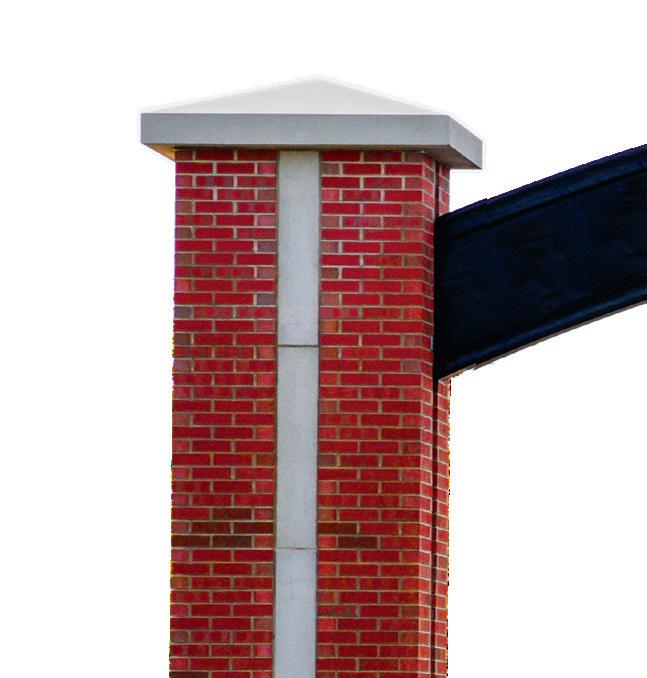
Beyond campus, AU added a new learning center in Woodstock, Illinois, and revitalized the George Williams College location in Williams Bay, Wisconsin, with a music pavillion in 2008, a chapel and garden in 2018, and the restoration of the natural lakefront setting in 2021.
2003

Institute for Collaboration

The three-story Institute for Collaboration is the centerpiece of campus. It houses 29 classrooms, more than 60 office spaces, Tru Blu Coffee, a literacy resource center, and gathering spaces. The building, nicknamed ICE, is home to the 500-seat Crimi Auditorium, the largest performance hall on AU’s campus, named in recognition of James E. Crimi, Aurora College president from 1962 to 1973, and his wife, Pauline, both alumni. Acoustically designed as a concert hall, Crimi hosts concerts, lectures, and events and boasts a 1,230-pipe Opus 119 organ.
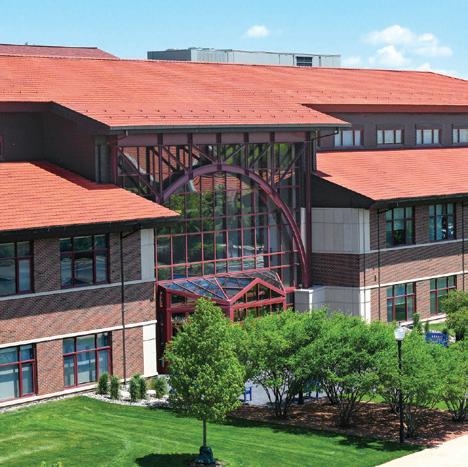
2012
Wackerlin Center for Faith and Action
Originally designed as a private home by the Chicago firm of Keck & Keck and inspired by the work of Frank Lloyd Wright, this retreat-like space provides members of the AU community an ideal area to contemplate and discuss issues of faith, service, reflection, and purpose. The building also houses Libby’s Place, the on-campus food pantry for students. The Wackerlin Center program was established in 2001 with a generous gift from 1918 Aurora College alumna Helena Zentmyer Wackerlin and was previously located in Eckhart Hall.
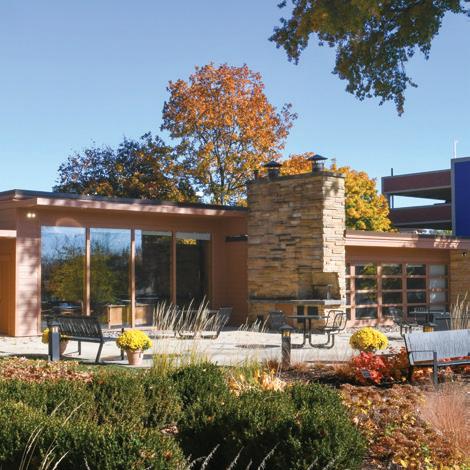
2012
Centennial Hall
Named for the 100th anniver sary of the institution’s move from Mendota to Aurora, Illinois, this four-story resi dence hall houses more than 100 students in airconditioned double rooms.

2014
John C. Dunham Hall is home to health sciences programs and includes biology and chemistry labs. It also offers spaces for individual and group study. The U.S. Green Building Council awarded the building the prestigious Leadership in Energy Envi ronmental Design (LEED) Platinum certification.
Opened originally as a STEM school for elementary and middle school students in the surrounding school districts, the building was refurbished in 2022 to house university classes.

18 Aurora University Magazine | FALL/WINTER 2022
John C. Dunham Hall
A Sense of Place
2015

Hill Welcome Center

At the entrance to campus, the Hill Welcome Center pro vides distinguished gathering spaces for campus and com munity functions, including educational events, meetings, dinners, and receptions. Inside, the Ethel W. Tapper Recital Hall offers intimate performance space for up to 80 guests. The Schingoethe Center, the university’s on-campus museum, moved into the Hill Center in 2015, and two years later received designation as a Smithsonian Institution affiliate.
2019
Parking garage
On-campus parking expanded with the addition of a fourstory, 500-space parking garage. Careful consideration was given to the structure’s design, ensuring it blended in with the existing campus architecture.

2021

Kimberly and James Hill Center for Student Success
The single-story building touts expansive windows and plenty of natural light, offering an inspiring space for students to explore vocations and careers. Students come to the center to study, meet with advisors, attend workshops, and enjoy the fireplace in the great room. The center also houses Spartan Attic, which provides free gently used and new professional clothing to students.
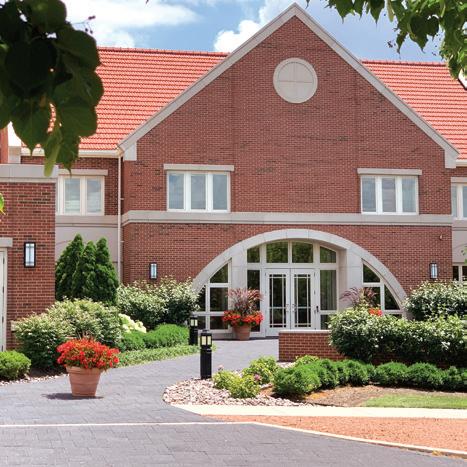
2022




Don and Betty Tucker Hall
Tucker Hall, formerly West Hall, is a living and learn ing center that features 70 resident rooms, several study areas, a fitness center, and program offices. The building adheres to universal design, ensuring that all spaces are sensory friendly and serve a wide variety of student needs. The main floor houses the Betty Parke Tucker Center for Neurodiversity, the Mesirow Learning Lab, and staff offices for the Pathways program for students with autism.

IN NEW CONSTRUCTION, RENOVATION, AND CAPITAL IMPROVEMENTS 43% INCREASE IN CAMPUS FOOTPRINT 9 NEW BUILDINGS CONSTRUCTED 176 GUEST ARTISTS, AUTHORS, AND PERFORMERS 1 MUSEUM WING OPENED Aurora University Magazine | FALL/WINTER 2022 19
The 80-acre Spartan Athletic Park, built in 2017, is located less than a mile from AU’s main campus and houses championship-quality venues for football, lacrosse, soccer, and softball. In 2021, AU added an indoor facility with an elite wrestling center, golf simulators, batting cages, and a weight room.
Opening the Door to the Arts
In the past two decades, AU has opened its doors to the arts, creating new performance spaces and enriching the cultural and intellectual lives of the AU community.
A strong proponent of the arts, President Sherrick revived the annual Music by the Lake outdoor summer music festival at George Williams College in 2000 and expanded cultural opportunities for Aurora and the surrounding community with the launch of AU’s Celebrating Arts and Ideas program in 2006.

Nearly 200 performers—authors, singers, dancers, musicians, artists, and speakers—have appeared at AU and GWC in the past 22 years in events that are open to the public. Among them: Doris Kearns Goodwin, David McCullough, Neil deGrasse Tyson, Music of the Baroque, Three Dog Night, the Beach Boys, Lyle Lovett, the BoDeans, Ramsey Lewis, the Joffrey Ballet, and several operas.
At the same time, the university opened a museum wing, acquired hundreds of pieces of artwork, planted scores of plants and trees, installed a 1,230-pipe organ, and a paved a labyrinth path.

20 Aurora University Magazine | FALL/WINTER 2022
“
Living and learning in a beautiful environment allows you to gain perspective and think beyond yourself.”
A Sense of Place
—Teri Tomaszkiewicz, senior vice president for alumni relations and career services
At George Williams College, the Music by the Lake outdoor summer festival upgraded to a new venue in 2008 with the construc tion of the Ferro Pavilion. Mean while, the historic Ingalls Building was transformed into a chapel and garden in 2018.



On the main campus, AU pulled out all the stops to acquire the Opus 119 pipe organ in 2010. The mag isterial sounds of its 1,230 pipes can be heard at Crimi Auditorium during chorale concerts, convocations, and other special events.
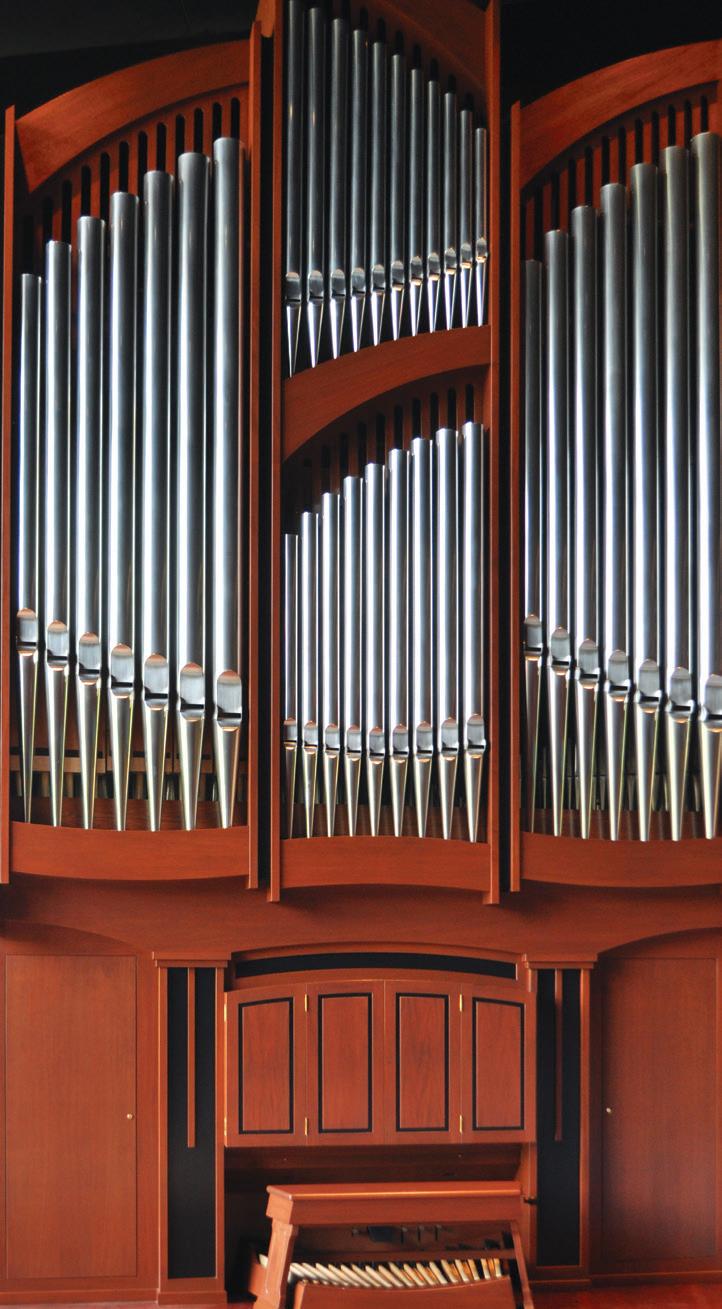
Aurora University Magazine | FALL/WINTER 2022 21
Our Favorite Places




1 4 7


—Kylie Janouskovec ’25



2. I enjoy meeting friends outside of the new ’15, ’20 MBA
We asked alumni and students to share some of their favorite places on campus. Here’s what they said. 2
5
4. I really enjoy visiting the Kimberly and James Hill Center for Student Success. The staff is super helpful with job-related topics and the building has a homey feel.
5.
—Amanda (Doubet) Seier ’01

6. I enjoy the ambiance of the Wackerlin Center


I especially like to go there when I’m looking for a relax ing place to study.
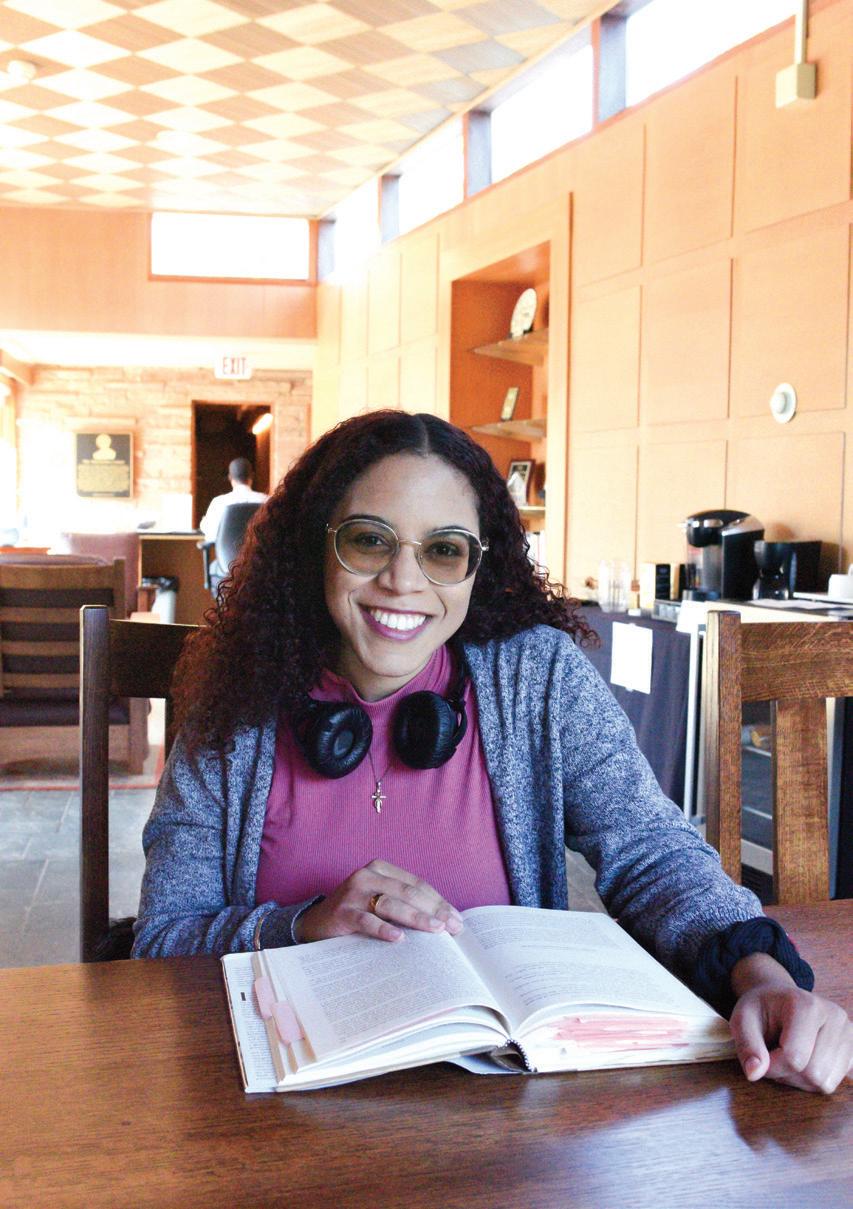
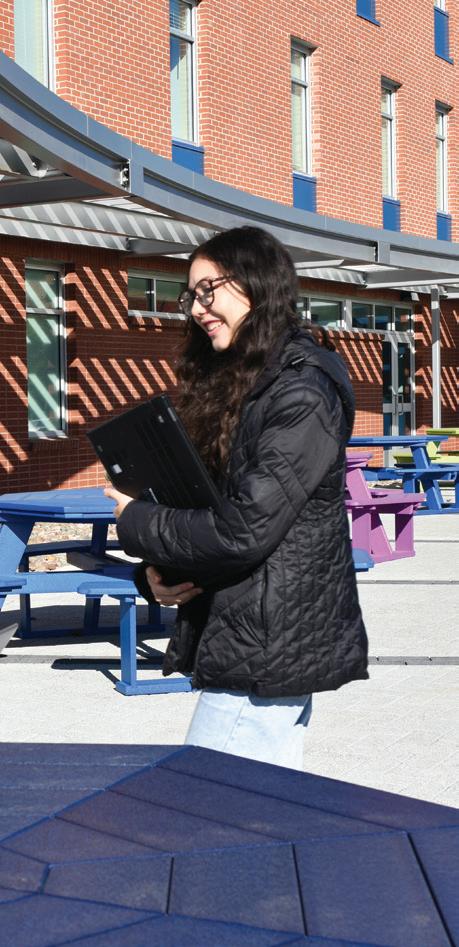
—Nayeli Benitez ’23
8. I really love the lobby of the Institute for Collaboration. It’s always filled with chatter and smiling faces.
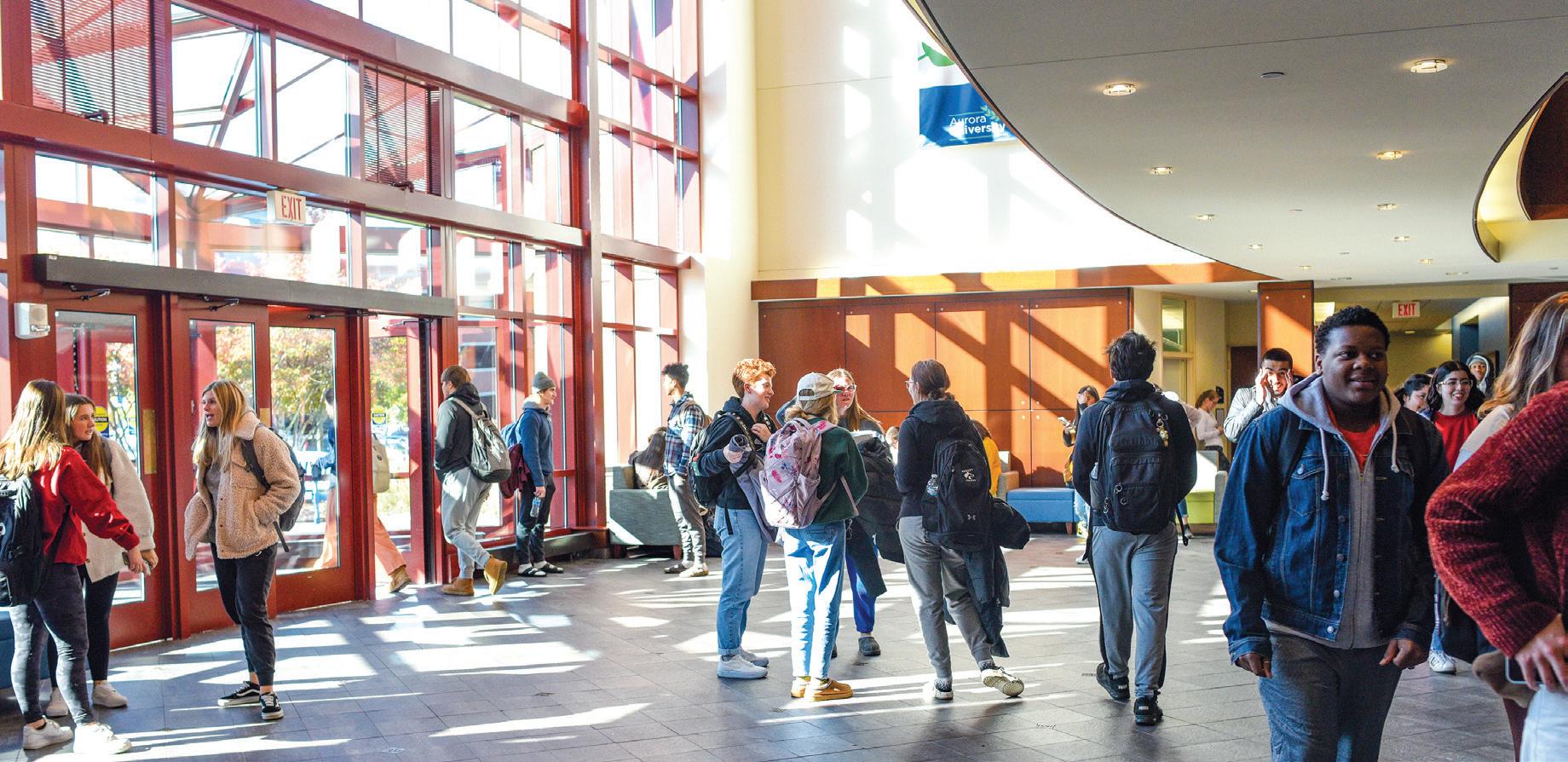
—Gabby Riley ’23
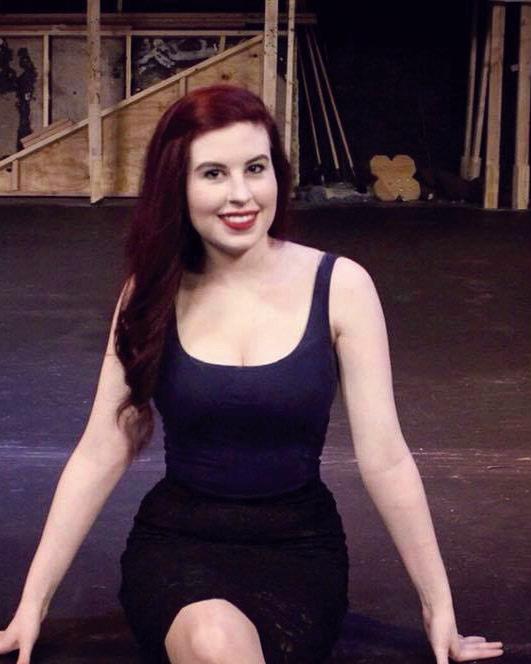


The Commons and the Quad—you could always find a friend to chat with in either spot!
3
8
6
Sense of Place
The Tiles That Bind Us
With a mix of landmark historic buildings and contemporary learning spaces, the AU campus strikes a balance between the past and the present. The distinctive, red-tiled roofs on the build ings are a legacy of early benefactor Charles Eckhart, an Advent Christian and auto-industry businessman. Eckhart funded construction for the first building on campus in 1912, Eckhart Hall, and specified that the red-tiled roof remain a feature in future construction. As the campus has expanded, AU has stayed true to Eckhart’s vision of unifying the varied architecture with red roofs.

24 Aurora University Magazine | FALL/WINTER 2022
A
AN IDEA FACTORY
Front Door to the Future
Over the past two decades, many existing campus build ings were renovated. Others were constructed. Now AU is looking to the future by imagining a new Learning Commons that will provide the core services available in an excellent small university academic library.

While the great libraries of the past essentially were repositories of manuscripts and bound volumes, today’s facilities are portals to the world beyond. With global information access available literally at our fingertips, digital sources and delivery models are ever more important. Ironically, AU’s new Learning Commons will open with fewer books on shelves, but a world full of
resources available to AU’s students, faculty, and staff thanks to technology. More and more, the university community will rely upon these digital sources and delivery models.
This dynamic 40,000-square-foot facility will blend the distinctive AU emphasis on individualized teach ing and learning with emerging trends in educational design and instructional technology. Library, informa tion technology, and academic support services, as well as experiential learning settings will be integrated to create the full spectrum of resources and services neces sary to realize ambitious educational goals.
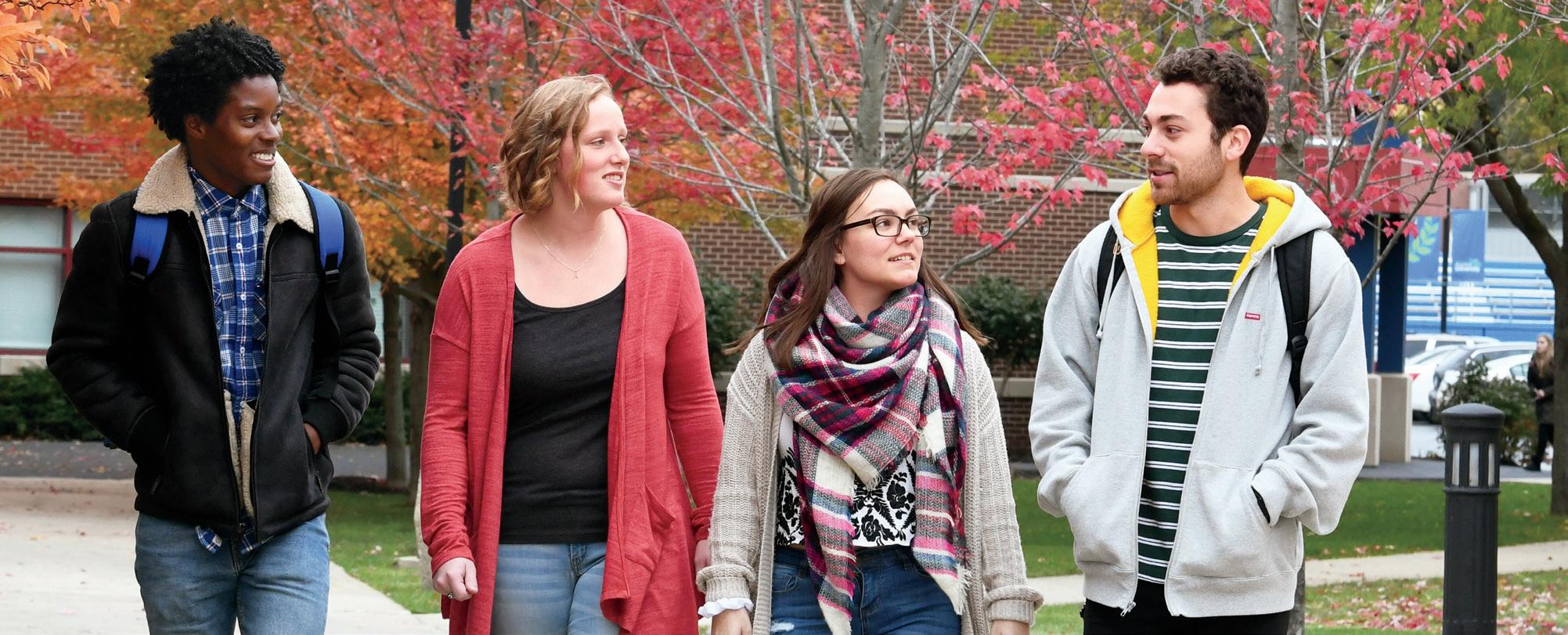
Aurora University Magazine | FALL/WINTER 2022 25
The proposed Learning Commons will create just the right atmosphere for study, collab orative projects, conversations, and exploration.

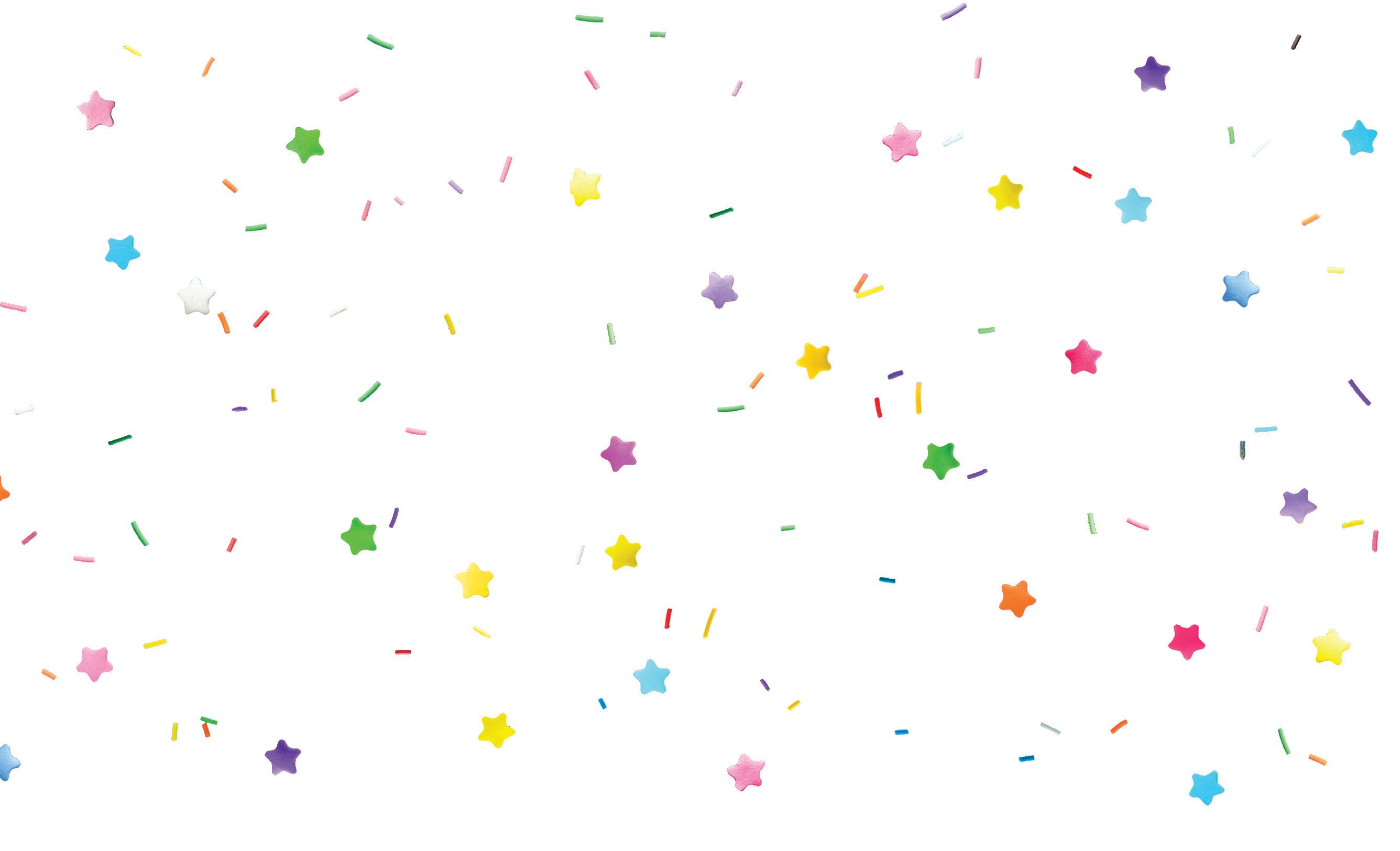

Tamara Turner ’12, ’14 MBA has taken her love of cake to new heights— 35,000 feet into the stratosphere, to be precise.
“She had a drive and a goal to make a difference,” said Michael Hensley, who was Turner’s professor for leadership and strategic plan ning at AU when she went through the MBA program.
She drew on the leadership, accounting, and management skills she developed at AU to adapt to the market.
“She had an incredible ability to overcome hurdles,” said Hensley, senior vice president of sales at NetScout Systems. “She has got an ‘it’ factor that is backed up by being accountable to herself. She holds herself to such a higher level. That’s like a gift from God as a professor or coach when you get to work with somebody like that.”
Hensley remains Turner’s mentor today, and she regularly calls him when she needs advice or has good news to share—like when she landed the American Airlines deal.
The founder and CEO of Chicagobased Silver Spoon Desserts began selling her mini gourmet Bundt cakes to American Airlines in January. The Fort Worth, Texas-based airline is serving the cakes to its first-class passengers on domestic flights.

It was a big break for the fiveyear-old business, and has led to other national firms lining up, wait ing to place orders.
“I have a big dream,” said Turner. “I want to expand. I plan to be in national chains. I’ve always believed you work hard and you can do anything.”
An Aurora native, Turner was a single mom, working two jobs in the catering and restaurant industry, when she came to Aurora University— first earning a bachelor’s degree in psychology and then going through the evening MBA program. She had her sights on landing a corporate position, but the entrepreneurial spirit was calling, and what she really wanted was to be her own boss.
Turner was helping to run an Aurora barbecue restaurant, and nearing age 50, when she puzzled over her life’s direction. Then came the leavening moment.
“On July 25, 2017, I heard the voice of God tell me at 4:30 in the morning, ‘Do the cakes first,’” she said. “That’s all I heard. It was a lit tle bit scary, like, who’s in my living room? But then I knew I had it in me all along. I knew what to do with the rest of my life.”
The next month, Turner founded Silver Spoon Desserts. She started baking out of her home kitchen, combining a cake recipe, handed down from her great-great-aunt, with her knack for creating upscale packaging. She initially made baked desserts for weddings, birthdays, and small conferences, but after winning several business competitions she fine-tuned her business plan to focus on the commercial market.
American Airlines, one of the world’s largest airlines, first took an interest in Turner shortly after she started Silver Spoon Desserts, advis ing her to cut the cake sizes by half to fit into the airplane galley.

After a stint working out of a Dunkin’ Donuts kitchen, she relo cated to a 16,000-square-foot facility in Chicago’s Archer Heights neigh borhood that once was occupied by Smith Bros. Cough Drops. Today, Turner has 17 employees, including two of her four children.
Now that she is established, Turner is forming a foundation, called Freedom, to support her employees.
“Yes, my cakes are sweet little desserts, but they’re more than that,” said Turner. “I hire people in the neighborhood, people who need work. I hire single mothers because I know the strains, the struggles, and the pains that come with that. Creating economic sustainability— that’s freedom to me.”
Aurora University Magazine | FALL/WINTER 2022 27
Sweet Success
For the Love of the Game
Spartans baseball is setting new records
ead coach Adam Stevens remembers the exact moment when he knew the baseball team he had been recruited to rebuild was starting to come together.
The Spartans have appeared in four straight NCAA Division III tourna ments—one of only four DIII schools to do so nationally.
It was the spring of 2017, three years into his job as head coach. The Spartans had a promising 26–16 season and finished second in the Northern Athletics Collegiate Conference. They had advanced to the fourth game of the champion ship tournament and were playing Milwaukee School of Engineering, a team they were predicted to beat, when they suc cumbed to a

heartbreaking 3–2 loss. It was a hard-fought, close game.
Stevens watched as the players gathered on a field outside of the stadium after the game, shedding tears and hugging each other for the next two hours.
“I remember sitting there watch ing and thinking to myself, we have a good thing going here,” said Ste vens. “We couldn’t get them to leave. It was really cool to see, because that meant they cared about each other and were invested in the success of the team, that they had had a good
experience and they didn’t want it to end. That was a sign to me that we were going in the right direction. The next year we broke through and began winning.”
In 2018, the Spartans finished 30–15, won the conference tournament, and qualified for the NCAA tourna ment for the first time in six years.
All told, in the past four full seasons (not counting pandemicshortened 2020), AU baseball has won three NACC tournament crowns and two regular-season con ference titles, tied the school record with 38 wins in 2021, and appeared in four straight NCAA Division III tournaments—one of only four DIII schools to do so nationally. The team has ranked in the DIII national top 25 every week for the past two seasons.

That’s good progress for a team that was 10–28 the season before Stevens arrived and barely better than .500 during his first two years in the Spartans dugout. “Team chemistry is so important to success,” said Stevens. “You want the players invested and caring for each other. We stress in recruiting to look for students that fit those characteristics. Ultimately, it’s about all the work they put in and the work it takes to be successful, and they do it together all year long.”
1926
1930s
1949
1959
1974
Athletics
With Percy Snell as coach, Aurora finishes its first base ball season at 4–1.
The newly christened Spartans register winning baseball records in 1934 and 1936.
Baseball resumes after a break during World War II, and the Spartans are 2–0 in their return to the field.
Snell Field is opened and dedicated in memory of Coach Percy Snell, the first coach hired by Aurora College. Snell Field hosted baseball games for nearly 50 years.
Spartans baseball, led by coach Fred Bornkamp, wins the school’s first conference champion ship—and wins again in 1978.
A History of Spartan Baseball
Stevens came to Aurora in 2014 after coaching 11 years at Central College in Pella, Iowa. He landed the job as head baseball coach at Central at age 24, shortly after graduating from Morningside Col lege in Sioux City, Iowa. As a young coach, he read and studied up on all the great coaches, from baseball to basketball to football. He soon made his mark, leading Central to its first conference championship in 64 years.

“Adam was a proven winner at a rural institution in which it is often a challenge to recruit athletes,” said Jim Hamad, vice president for athletics. “He also received his first head coaching opportunity at a very young age. By the time he expressed an interest in Aurora, he was a fully developed coach.”

When coaching, Stevens focuses on the basics: fundamentals, work ethic, attitude, and a team-first mentality. He also teaches his play ers to take responsibility to develop their skills as leaders on and off of the field.
“He holds us to a high standard and we, in turn, hold each other to a high standard as players,” said first baseman Justin Sartori ’23, from Sandwich, Illinois.

In just eight years at AU, Stevens has already posted the second-best winning percentage in Spartan baseball’s 96-year history.

The combination of Aurora’s winning tradition and Stevens’ self-leadership philosophy appealed to Sartori, the Spartans’ most deco rated player. Last season he earned Division III All-American honors after batting .375, with 12 homers, 59 runs scored, and a school-record 70 RBIs. He also made DIII Aca demic All-American.
“Everyone has a role on the team, no matter how big or small,” Sartori said. “Coach Stevens cares about everyone on the roster, regardless of their baseball abilities. As a player, I have always felt like he had my best interests in mind at all times.”
In just eight years at AU, Stevens has already posted the second-best
19831992
20032012
winning percentage—.684—in Spartan baseball’s 96-year history. Mark Walsh ’76, who coached from 1993 to 2002 and later became AU’s athletic director, holds the record with .789.
With the Spartans becoming a fixture in the Division III tourna ment, Stevens’ next goal is to one day win a national championship.
“It’s extremely challenging to maintain excellence,” Stevens said. “Every year is a new year. Handling success is sometimes harder than dealing with failure. Team chemistry wins as many games as talent. The best recruiting you can do is give your players a great experience.”
2019
Coach Adam Stevens led the Spartans to three conference tourney titles and four NCAA berths.
“Team chemistry is so important to success. You want the players invested and caring for each other.”
Aurora University Magazine | FALL/WINTER 2022 29
Coach Jim Schmid (245–122–2) ushers in Aurora’s first “golden age” in baseball. The Spartans win nine straight conference crowns and qualify for their first NCAA Division III tournament in 1987.
Mark Walsh ’76 (320–8–52), Aurora’s all-time winningest coach, guides the Spartans to nine conference crowns and nine NCAA berths in 10 seasons.
19932002
Coach Shaun Neitzel (287–147–2) nearly matches Walsh’s pace with five conference tournament titles and six NCAA berths.
Adam Stevens starts his first season as Aurora’s 17th head baseball coach. He has led AU to three confer ence tourney titles and four NCAA berths.
2015
A new home field for Spartan baseball is established at the Fox Valley Park District’s Stuart Sports Complex, 4 miles west of campus, and is named after leg endary AU coach Jim Schmid
The Aurora University Spartan Athletics program had another successful season in the 2021–2022 academic year.



The baseball, football, women’s lacrosse, men’s golf, wom en’s golf, women’s hockey, and women’s volleyball teams all advanced to NCAA Division III regional tournaments.


Robbie Peterson Jr. ’23 competed in the triple jump at both the indoor and outdoor 2022 NCAA track and field cham pionships, and Deyanneira Colon Maldonado ’25 competed in women’s cross country.


Baseball, women’s bowling, football, men’s golf, women’s golf, men’s lacrosse, women’s lacrosse, and women’s volleyball all won conference championships.
The AU Athletic programs also had a strong showing in the Learfield Sports Directors’ Cup, finishing the year ranking 76 out of the more than 450 athletic programs in Learfield’s Division III standings. The Learfield Sports Directors’ Cup is a comprehensive ranking of intercollegiate athletic departments based on their participation in NCAA championship events.

Individually, AU student-athletes also had a tremendous year garnering athletic awards, with eight All-Americans, four Academic All-Americans, 24 All-Region players, nine Con ference Players of the Year, eight Freshmen of the Year, and seven Conference Coaches of the Year. More than 100 Spar tans earned All-Conference recognition.
Among the top accolades: Spartan baseball infielder Justin Sartori ’23 was named 2021–2022 NACC Male StudentAthlete of the Year. And baseball head coach Adam Stevens and men’s golf head coach Justin Wyeth were both named Regional Coach of the Year.


8 24 CONFERENCE CHAMPIONSHIPS ALL-REGION PLAYERS LEARFIELD SPORTS DIRECTORS’ CUP RANKING 30 Aurora University Magazine | FALL/WINTER 2022 352 3.25 SPARTAN STUDENTATHLETES EARNED A GPA OR HIGHER # 76
SPARTAN ATHLETICS BY THE NUMBERS SPARTAN SPORTS
ROUNDUP
Investing in Student Success
AU graduates are engaged in all walks of life. They serve as teachers, nurses, business leaders, police officers, social workers, entre preneurs, and accountants. Every gift, no matter the size, helps to prepare students for success in their chosen professions and to shape the future of our communities.
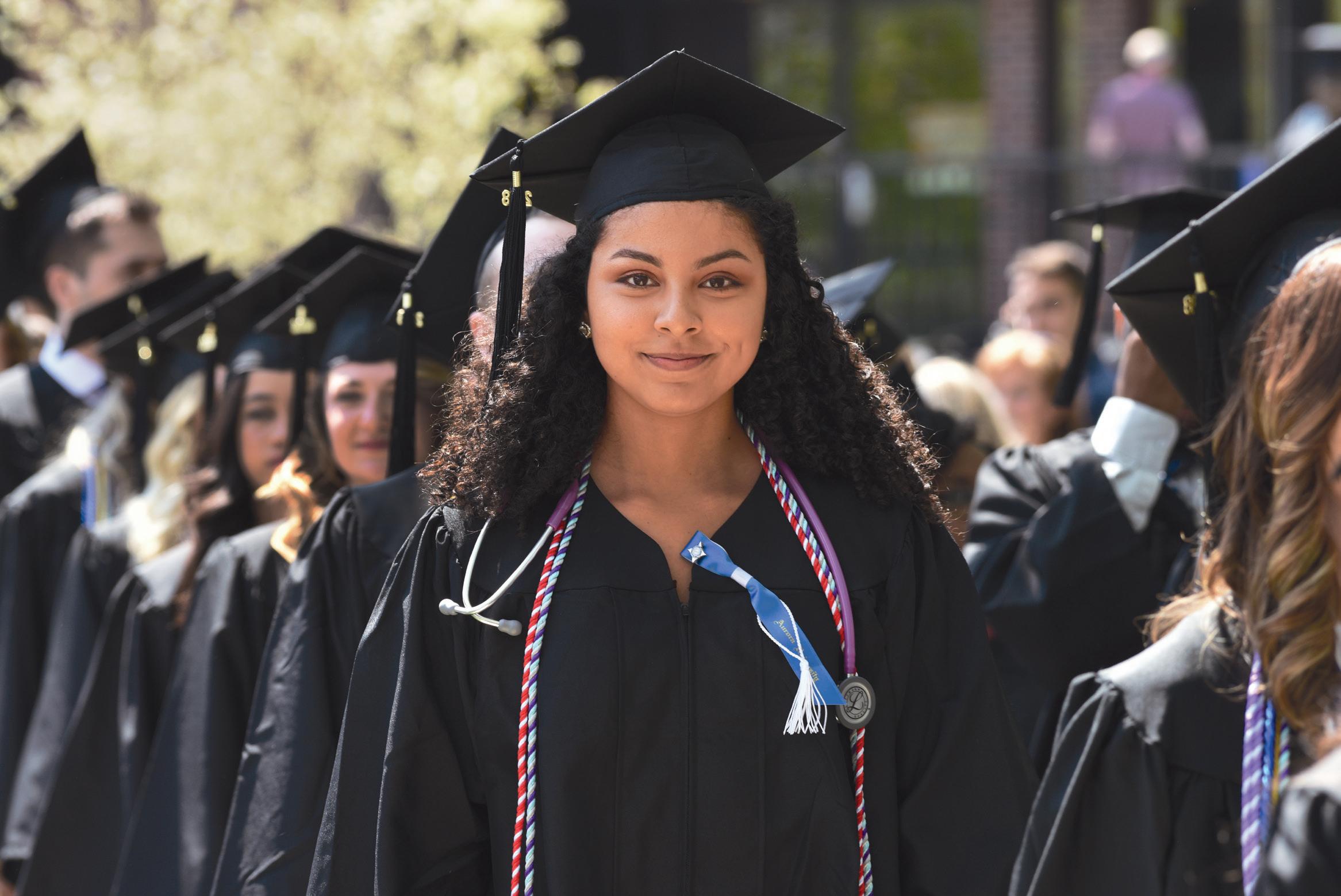
Student scholarships continue to be a high priority. Gifts to the Fund for Student Suc cess provide direct support to students, many of whom are paying their own way. As you consider making a gift, know that your con tribution impacts our students, making it possible for each to discover what matters and build a life of meaning and purpose.
Become a part of continuing the tradition of student success by making your gift online at aurora.edu/give For more information, contact Meg Howes, senior vice president for advancement, at 630-844-5256 or mhowes@aurora.edu .

Aurora University Magazine | FALL/WINTER 2022 31
Our commitment at Aurora University is to help each student achieve his or her full potential.
Giving
Pertl Receives 2022 Trumbo Award for Excellence in Teaching

Since its incep tion in 1976, the Marcus and Mark H. Trumbo Award for Excellence in Teaching has served to recognize the finest work of Aurora University full-time faculty in their roles as teachers, mentors, and scholars.
Aurora University awarded its most prestigious faculty recognition to Lisa Pertl, MSN, RN, CNRN, CNE, associate professor of nurs ing. The Marcus and Mark H. Trumbo Award for Excellence in Teaching is presented annually to acknowledge the finest work of full-time AU faculty as teachers, mentors, and scholars.
Pertl, who holds the Judith B. Dunham Distinguished Pro fessorship in Nursing, was honored for her positive attitude and unwavering support of students and her involvement in organiza tions that focus on the state of intellectual development and the promotion of social justice. Students and colleagues alike praised Pertl for her deep commitment in helping students pursue their academic goals and in creating opportunities for them outside of the classroom.
Earlier this year, Pertl was named a 2022 Nurse Educator Fellow by the Illinois Board of Higher Education and the Illinois Depart ment of Financial and Professional Regulation/Illinois Nursing Workforce Center and Advisory Board. The fellowship includes a $10,000 award to help promote excellence in nursing education.
Before joining AU in 2015, Pertl spent 30 years in the field at Northwestern Medicine Delnor Hospital, where she worked as an intensive care unit nurse and then became the neuroscience nurse facilitator. She was also a part-time clinical nursing instructor for Waubonsee Community College.
Drawing Blood, Checking Heartbeats
Senior lecturer Jay Shahed, MD, MBA, piloted two medical certi fication courses this summer, in phlebotomy and EKG technology, as the School of Health Sciences expands its curriculum.
The two new medical certifica tion courses are designed to help students gain the experience needed to successfully apply for healthcare jobs, medical school, and research opportunities.
“One of the most important requirements in finding a job in the healthcare industry after graduation is having previous experience in the field,” said Shahed, chair of health care administration and clinical certification courses. “By developing certification courses, we hope to provide students with the hands-on training they need.”
Students pursuing careers in the health science and medical fields typically need to accumulate patient contact hours as part of their appli cation credentials. The eight-week certification courses—launched this past summer on Aurora University’s main campus—prepare students to sit for their certification exams.
More than 40 students enrolled in the courses. They learned how to set up and administer EKGs and stress tests, prepare patients for
32 Aurora University Magazine | FALL/WINTER 2022
AWARDS AND ACCOLADES
Faculty News
Assistant professor of computer science
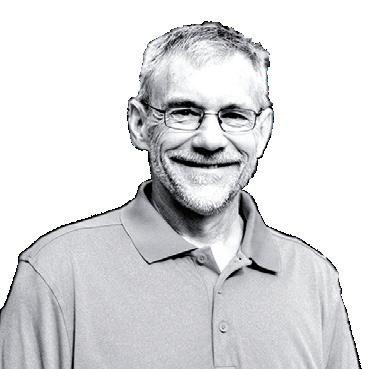
“Through our partnership with Aldi technology managers, students get to experience what it would be like to work with a customer on a big software development project.”
Students learned how to take blood as part of a new course to become a certified phlebotomist.

Holter monitors, and compile final test results for physicians. Students also gained experience taking blood with venipunctures and capillary sticks by practicing on each other.
All the students passed their certification exams. Many of the students found part-time jobs soon after they became certified and are working in their desired field as they continue their university studies, Shahed said.
The School of Health Sciences plans to offer the medical certifica tion courses again next summer and is exploring adding more professional preparation courses to the series.
In Brief
Thanks to the advocacy work of Laura Donavon, LCSW, assistant professor of social work, Aurora University’s social work program received approval from the Illinois Certification Board to offer the Certified Alcohol and Other Drug Counselor (CADC) program fully online. With the addition of the online option, the opportunity to earn this valuable credential will be made available widely to students throughout Illinois. Commu nities across the state will also benefit from the increased presence of creden tialed professionals to fill a shortage of workers needed in this crucial prac tice area.
Greg Goalwin, PhD, assistant professor and chair of sociology, had his book “Borders of Belief: Religious Nationalism and the Formation of Identity in Ireland and Turkey,” published in July by Rut gers University Press.
David Lash, MS, assistant professor of computer science, is developing an ongoing partnership with discount grocer Aldi Inc.’s U.S. headquarters in Batavia to help students get a firsthand look at computer science careers. In one project, Aldi technology manag ers visit the classroom for a software technology course posing as custom ers. The interaction gives students an opportunity to experience what it would be like to work with a customer on a big project, including how to clarify requirements, review progress, and set direction. The managers also take part in panel discussions to answer students’ questions about what it’s like working in the field and what employers look for in job candidates
James Kao, MFA, associate professor of art, presented a solo exhibition of new paintings at Goldfinch Gallery in Chicago this past fall. The exhibition titled, “something about grinding down, something about glittering,” is taken from a poem by Kao’s good friend, Sarah Bitter, and refers to the way sand marks the earth’s surface, and expresses wonderment about the con struction of future ruins. Kao created these works on sabbatical leave while traveling across the deserts, mountains, and forests of the American West.
Aurora University Magazine | FALL/WINTER 2022 33
David Lash
Everyone needs a hug now and then. Artist Rita Grendze encourages it.
In her installation “Collective Comfort,” the fiber artist turned baskets of yarn she discovered while at home during the pan demic into soft, colorful vines just waiting to be hugged.


The piece speaks to the natural human longing for touch that was lost during the height of the COVID-19 pandemic when people had to physically distance them selves, she said.
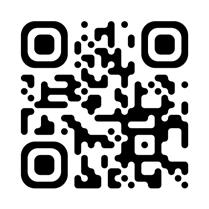
“It’s a pretty direct response to the trauma of the past several years on the world,” said Grendze. “I suddenly found myself wanting to take everything I love, everyone I love, and give them a huge hug and say, ‘I know it’s not OK today, but I believe that collectively we can make things better.”’
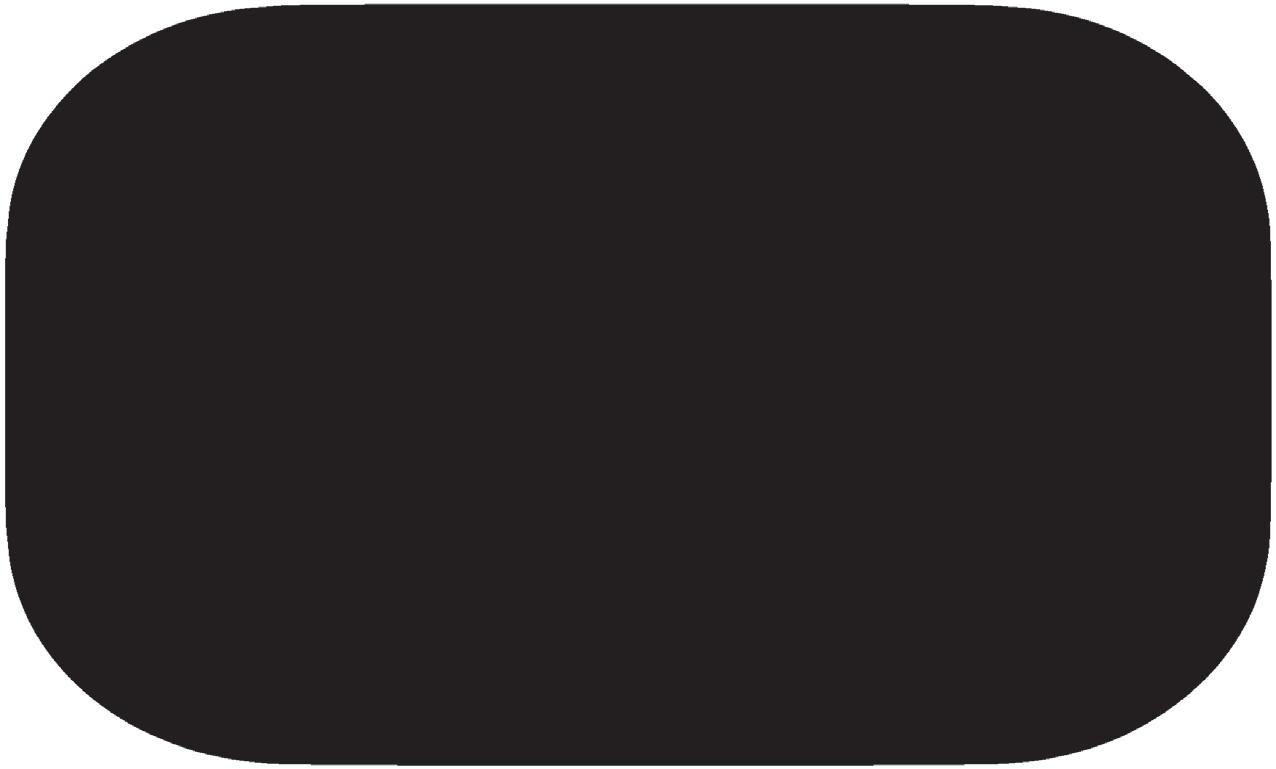
&Culture
Arts
34 Aurora University Magazine | FALL/WINTER 2022
Rita Grendze is a first-generation American born to immigrant Latvian parents. “Collective Comfort” has been on display at the Schingoethe Center of Aurora University for the fall semester and is scheduled to travel to other local venues next year. Grendze works out of her studio based in Geneva, Illinois.
Watch the video here.
Matthew Kneller: What led you to write “The War for Kindness”?
Jamil Zaki: I’ve been studying empathy for quite a long time. And I never really felt like I had something new to say about it for a general audience. Then my lab and I started to come up with a new theory—a view of empathy not as a trait but as a skill, something that anyone can work on.
Kneller: Did anything surprise you?
Zaki: Empathy and kindness have thrived during the pandemic, but people don’t notice it. The pattern is opposite to our intuition. There is so much good happening in the world, and yet people are convinced the world is worse than ever. When you measure it, you find that all forms of kindness skyrocketed in 2020 and 2021.

Kneller: Can you talk about empathy as a practical career or leadership skill?
Zaki: Decades of evidence have shown that empathy is a core leadership skill. Empathic people rise in their organiza tions faster than nonempathic people. They are seen by their teams in a positive light. When people are managed by people who are empathic, they are happier in their jobs, they call in less with stress-related illness, and they perform better. It’s one of the best tools we have for leadership.
That’s just one of the lessons Stanford University psychologist and scholar Jamil Zaki shared with students gathered at Crimi Auditorium in October to discuss his book, “The War for Kindness: Building Empathy in a Fractured World.” The book was the fall semester’s common read for first-year students.
The private session was followed by Zaki’s public lecture as part of Aurora University’s longstanding Celebrating Arts and Idea s series. Matthew Kneller, professor of communication and director of general education, moderated the student session.
Here are edited highlights:
EMPATHY AND KINDNESS HAVE THRIVED DURING THE PANDEMIC, BUT PEOPLE DON’T NOTICE IT.

“ “
Kneller: Did you learn anything new in the process of writing the book?
Zaki: I learned how hard self-compas sion is for people. A lot of people have extremely strong empathy for everybody in the world except themselves. I also learned that empathy is not just about the individual but about the community around us. You can be as empathic as you want, but if you go into a community where people are bullying each other, where they are cruel and divided, your empathy will dry up. If you’re not that empathetic but enter a community that’s extraordinarily caring, your empathy will grow.
Aurora University Magazine | FALL/WINTER 2022 35
Being kind to others is one of the fastest ways to become happier yourself.
Back Story

Engagement Rock. When the founders of Aurora University moved the college from its birthplace in rural Mendota, Illinois, to the growing city of Aurora in 1912, they brought a piece of history with them—literally. The Class of 1914 transported a boulder to the college’s new home via railroad flatcar and placed it in front of Eckhart Hall, where it remains today. Engagement Rock, as it would later be known, became a popular spot for marriage proposals. The rock has since served as an iconic location for graduates and their families to have their photos taken and think fondly of their years at AU.

36 Aurora University Magazine | FALL/WINTER 2022
c.1925
Connect with us. KEEP IN TOUCH! AURORA UNIVERSITY IS YOUR UNIVERSITY. STAY UP-TO-DATE ON HAPPENINGS AROUND CAMPUS AND CONNECT WITH FELLOW ALUMNI. JOIN THE CONVERSATION ON FACEBOOK, INSTAGRAM, TWITTER, LINKEDIN, OR VISIT US ON YOUTUBE. aurora.edu/alumni augwcalumni gwcalumni @aurorau @auroraualumni aurorauniversity Aurora University
Alumni gathered for the first time in two years to celebrate Homecoming 2022 at AU and Coming Home 2022 at GWC.



